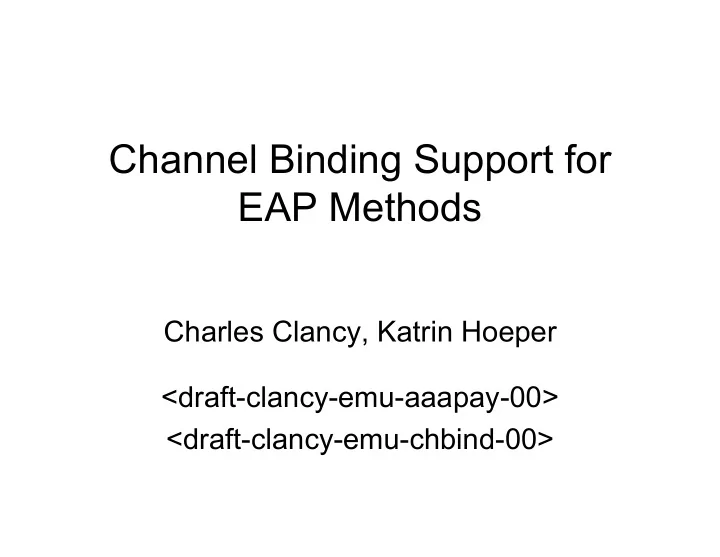

Channel Binding Support for EAP Methods Charles Clancy, Katrin Hoeper <draft-clancy-emu-aaapay-00> <draft-clancy-emu-chbind-00>
Definition • EAP channel bindings (c.b.) (as defined in the drafts) provide a consistency check of information advertized to peer and known by the authentication server from an authenticator acting as a pass-through device during an EAP session.
Goals • Bind information advertized by an authenticator to the channel and verify its consistency to prevent attacks by rogue authenticators. – E.g. prevent “lying NAS attacks”
Proposed Method Phase 1 . Information exchange – Peer sends info 1 to server – [Server sends info 2 to peer] Phase 2. Consistency check – Server verifies consistency and sends result to peer – [Peer verifies consistency and fails if inconsistent]
Data Exchange • I-D.clancy-emu-aaapay – Defines way to encapsulate arbitrary Diameter AVPs in the protected channels of existing EAP methods – Includes GPSK, PSK, PAX, TTLS, FAST • Channel binding information encoded in Diameter AVPs (or RADIUS TLVs using backward compatibility) • Data exchanged as part of EAP messages in end-to-end integrity-protected channel
Design Choices • Server performs consistency check • Explicit data exchange and verification – As opposed to implicit, e.g. by hashing identity and other information directly into keys • Benefits: 1. Enterprise: server more likely to be capable of recognizing whether different addresses belong to same device 2. Service Provider: more likely to know details of contractual roaming agreements 3. Easy add-on solution for EAP methods: no modifying EAP key derivations, message flow or state machine nor adding new algorithms or messages 4. Allows for fuzzy comparisons
Binding Information • Exact parameters to bind are open to discussion • Document provides placeholders for some EAP lower layers – IEEE 802.11 • SSID, BSSID, RSN IE (if present) – IKEv2, IEEE 802.16 and other EAP lower layers • TBD
Our Trust Model • Honest peer & authentication server; may be dishonest authenticator info 1 Authentication EAP peer Authenticator info 2 Server (NAS) info 1 ' [info 2 ], result • Trust relationships 1. server trusts that info 1 = info 1 ’ 2. peer trusts result 3. server trusts stored info 2
EAP Method Requirements • Peer ↔ AS trust relationship can be established by any EAP method with the following properties: – mutual authentication between peer and server – derivation of keying material including an integrity key – info 1 sent from peer to server over end-to-end integrity-protected channel – result (and optionally info 2 ) sent from server to peer over end-to-end integrity-protected channel
System Assumptions • Assume server maintains protected database of info 2 • Consistency check requires server to be capable of comparing provided information – Enterprise: validate information on a per- authenticator basis – Service Provider: validate information on a per-network basis • Both must be ensured outside EAP
Future Work • It’s a start, but much works remains to be done: – message flow, incl. EAP-success/failure cases – example attacks – binding information – security considerations – …
Questions? Comments?
Recommend
More recommend